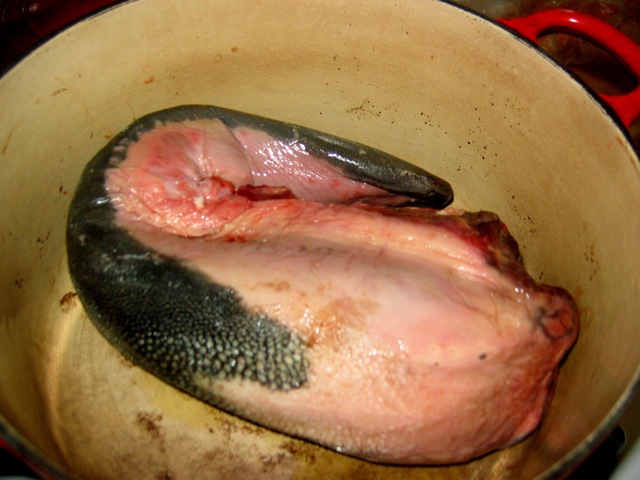
reference-image, l
(post, Caroline Cummins)
So last summer, my husband and I bought a quarter of a cow. Hung, butchered, wrapped, and frozen, it filled our entire chest freezer. Most of it wound up as ground beef, but a few less-than-choice cuts come with the territory. Thus far, we've tackled beef liver and beef tongue. The liver was, to put it succinctly, a bust. We soaked it in milk for a few days, on the theory that this would dull some of the, well, livery taste. (It's a good theory, since, as Matthew Amster-Burton explained in his column on milkshakes, the fat in dairy can flatten out sharper flavors.) Then we pan-fried it, ate a few bites, looked at each other, and gave the rest to the cat. It was just too strong a taste for us. And, heck, we like liver, at least the kind that comes in poultry; we're happy to pan-fry that stuff and spread it on bread any day. But this? This was overwhelming. At least, until I unwrapped the beef tongue. Holy cow. Holy cow. [%image reference-image float=left width=400 caption="One raw beef tongue, ready for braising."] This was, recognizably, a tongue. An enormous tongue — from a 1,000-pound steer, remember? A black tongue, covered in bristly-looking taste buds. I was, momentarily, horrified. I mean, I was perfectly willing to butcher and grill three of my chickens, but those were birds. Not mammals. For an instant, I fully understood vegetarianism, on that visceral level where disgust and revulsion congregate. But we had friends coming over for dinner the next night, friends who had also bought a quarter-cow with us and had expressed a willingness to try the tongue. And I had come up with an ambitious plan for cooking it: braising it and saucing it the way we'd had something sort of similar — beef cheeks — at a popular Walla Walla restaurant, Saffron. (Thanks to local food-and-wine magazine Northwest Palate, we also had the recipes for both beef and sauce.) So I dropped the tongue — thunk — into a Dutch oven and began braising it in red wine. It simmered for a few hours, and then I let it cool. It was still black, and quite firm. I poked it with a finger, watching the rubbery surface bounce back. Jesus. What was I supposed to do next? "Call Anya," my husband said. "She'll know what to do." It was 8:30 on a Friday night, but why not? Anya Fernald — the former director of Slow Food Nation and the current force behind Live Culture — knows meat. She'd already suggested asking our cow's butcher for eye of round, so we could cure our own bresaola in a wine fridge. (Alas, our butcher's skills were limited to only a few basic cuts, and eye of round wasn't one of them.) She would definitely know what to do. Fortunately, she was home. "OK, first you take off the taste buds. Then cut off the cartilage at the back. Then slice it really thin," she said. "Do you have a meat slicer? No? Well, take it to your local butcher shop and have them cut it for you. Buy a sausage or something, then hold up your tongue and say, 'By the way, would you cut this for me?' Once you've got it sliced, fan it out and pour a sauce over it, like a tonnato sauce or a salsa verde. Salt. You'll need salt. And that's it." Excellent. I took a knife to the taste buds and lo, they peeled away like, well, leather. The next night, my husband tackled the cartilage and the thin-slicing while I reheated my version of Saffron's sweet-and-sour eggplant sauce. Our friends arrived. If the tongue was truly terrible, I thought, we could always ditch it and boil water for pasta, using the eggplant as a pasta sauce. But it wasn't. It was good. Soft, pleasantly chewy, and good. Our pals even took some home with them as leftovers. Will I tackle a beef tongue again? Probably not; I like lengua tacos, but not enough to devote an entire day's worth of braising and chopping and saucing to them. Still, it's good to know that nose-to-tail cooking at home can be successful.

reference-image, l